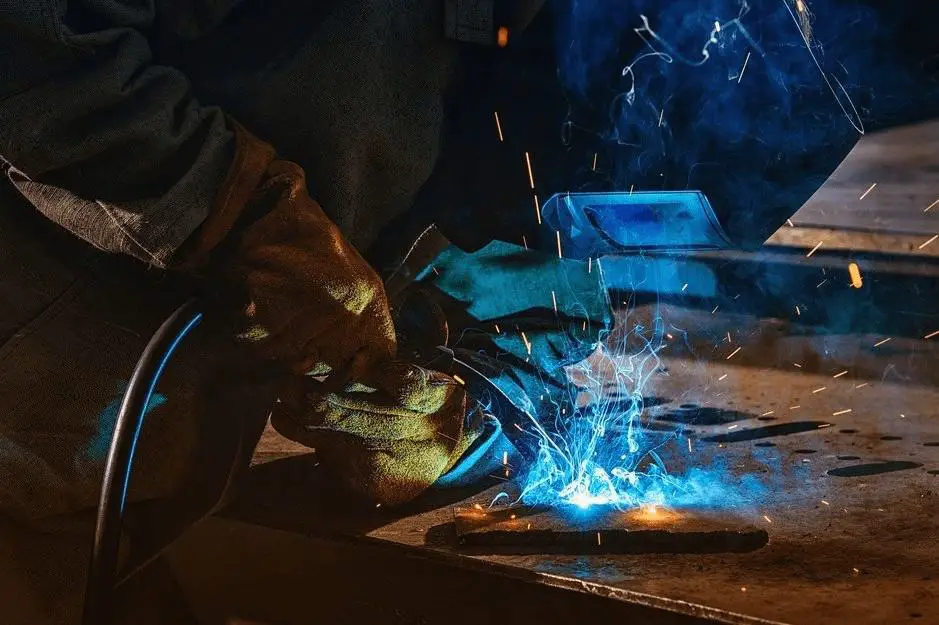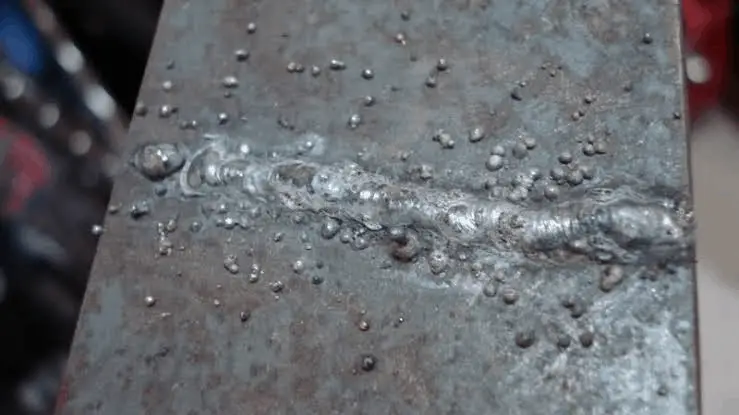You cannot avoid getting some weld spatter splashed all over your table during the welding process. No matter how many anti-spatter solutions you use it still will find its way on the working table. In MIG welding, the spatter will come about as the excess molten wire stands binding with everything else that is not been welt.
The spatter often forms near the welding arc and can be a great source of nuisance for the welder. The most common reasons for weld spatter is incorrect weld settings that result in high amperage or low voltage settings. You should note that in MIG welding the cause for high amperage is the wire feed speed.
There are a number of ways to remove weld spatter including scraping, grinding, blasting, and sanding.
Chipping
This is ideal for those easy to remove spatters. All you will need for this is a chisel and hammer. If the table is cluttered with spatters then this method may take awhile. To remove the spatter position the chisel at a 35 degree angle close to the edge of the spatter. This is to reduce chances of destruction to the working surface. Next, is to use your hammer to gently tap the end of the chisel as you try to remove the spatter. Increase the number and strength of the taps depending on how entrenched the spatter is to the table. As a rule wear safety glasses to prevent any foreign materials from getting into your eyes.
Flap disc
If the chisel does not do the work your next option is to use the flap disc. This is ideal if you have a large surface area with small and medium spatters. Using the flap disc is not that hard. First, ensure you have the right protective gear – gloves and goggles – then connect the flap disc to your angle grinder. All you now have to do is turn the flap disc on and start removing the spatters. If you find those that are embedded hard, then apply some more pressure. Be careful not to ruin your table.
Grinding
If you have tried the chisel hammer and the flap disc then it is time to bring in the grinder. The grinder is suitable for medium to large spatters. The process of removing the weld spatters is the same like the flap disc. Begin, by getting yourself some protective goggles and gloves. Connect it to your angle grinder and then put some light pressure on areas of your table with spatters. Once done sweep the spatters you have removed through regular sweeping.
How to reduce weld spatter

It is common to have welder even if you are an expert. For MIG welding you get more spatter than TIG welding. If you are experiencing excess spatter then here are some tips to reduce the amount of spatter.
Machine spatter settings
Most of the time the welder will forget to change the polarity from flux cored to solid wire. Anytime you notice that your arc is becoming rough then check your polarity. One of the leading causes of spatter is having the wire speed setting at too fast. If you are able to fine tune your welding settings to a more stable arc then you are going to see less spatter during welding. In some cases you will have a welding chart that offers you the ideal amperage and voltage settings. Overall, getting it right is something one gets as they gain more experience. Due to the varying welding machines available in the market the chart may not be that suitable as you will need to personalize your settings to get the ideal arc.
From the welding chart you will get the right voltage. Next, is to check the wire settings. Watch the arc for smoothness as you fine set the wire speed. If you have small adjustments then you will avoid cases of skipping a sweet spot. If you have changed the wire settings and voltage but still are not getting the ideal arc it is time to move to the coarse voltage change. You can know you are outside heat voltage settings when your arc starts to sputter and when you check the bead it is neither cold nor hot.
Welding technique
If the spatter keeps increasing then the problem is how you are welding. You need to follow right welding techniques to avoid spatter. For the best results you will need to position the weld at a position of 5 to 15 degrees. With this angle you will be able to have the shielding gas to cover the weld area. When you have your gun angle at a position that pushes the gas to one side then you will have more spatter as you have left one side unprotected.
Again if you have a very long electrode sticking out then it will cause jabs to your welding pool hence increasing spatter. To reduce spatter have a shorter arc. It the electrode is too short then you are going to experience more sputtering and spattering. Most welders recommend a stick out of ½ for flux cored welds and 3/8 inches for MIG welding. To have consistent welds then have your electrode at the right length.
Cleaning materials to reduce spatter

Contaminants are always present when you are welding. You will have grease, paint, rust or mill-scale. This contaminants make it harder to work on your metallic surfaces hence splashing the spatter. When it comes to rusty metals the best coarse of action for welding is to use flux core electrodes or stick welding as opposed to MIG. Flux core electrodes provide deeper penetration that works through the rust. Having the ideal wire for MIG is vital if you are going to work on rusty metal using the technique.
Welding preparation is vital if you are going to see less of spatter. If you do not prepare your surface no amount of welding expertise will prevent spatter. Many welders see preparation as a waste of time, but it does help if you want to have high quality welds. You can use a 4.5 inch angle spatter for this as it gives you a clean weld surface. Once done you can wipe down the surface with some acetone.
In addition, to the welding surface you also need to check out your wire spool for any signs of contamination. The wire does collect dirt with time resulting in erratic feeding. This leads to excess spatter. If you do a lot of welding you can remove the wire spool and place it in a ziplock to keep out contaminants.
Check the working clamp
A simple problem like weak connection in the working clamp can cause your welding arc to fluctuate hence causing spatters. Ensure that the clamp properly bites your working surface before you can place the base metal. To get the best results ensure that your clamp is as close to the weld as possible.
How the wire feeding mechanisms influences spatter
Part of removing weld spatter is preventing it from been there in the first place. Self-shielded flux core arcs (FCAW) are one of the most common welding techniques. It is used for heavy bridge repair, structural steel erection and heavy welding needs. FCAW offers higher deposition rates but the process is laden with many difficulties. To solve this, try out some of these tips. If you are working with a flux core welding technique then it is vital you watch out for wire malfunctions and feed stoppages. Two of the most common types of wire feeding problems include birdnesting and burnback. Burnback is caused by having the wire melts into a ball at the contact tip end. The problem with this is having a too slow wire feed. To avoid burnback try maintaining a contact tip distance of 1 ¼ inches. Birdnesting halts the wire from been fed by tangling it. To solve this use U-groove and knurled V wire feeds.
Having the right wire feed can save you from spatter. The wire feed tension should not be too lose or too tight. It should not be too lose as to cause the driver rollers to fall out. Check for dust accumulation in the drive rollers. This dust when not sorted will find its way to the wires. If you disengage the drive tensioner you should be able to move the wire back and forth. If you have a dirty or rusty wire you are going to experience erratic feeding that will lead to more spatter.
Lastly, watch out that you have enough shielding gas for MIG welding. This gas is paramount in stabilizing the arc hence producing less spatter. Identify the right shielding gas for your applications.
Conclusion
To remove spatter the first technique is chipping. This involves the use of a hammer. Chipping helps remove most of the small spatters. If this is not enough try out a flap disc. This should eliminate most of the small to medium spatters. If these two do not work then it is time to use a grinder. Instead of waiting for spatter to appear you can take the steps mentioned above to prevent its appearance.
